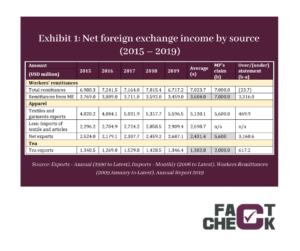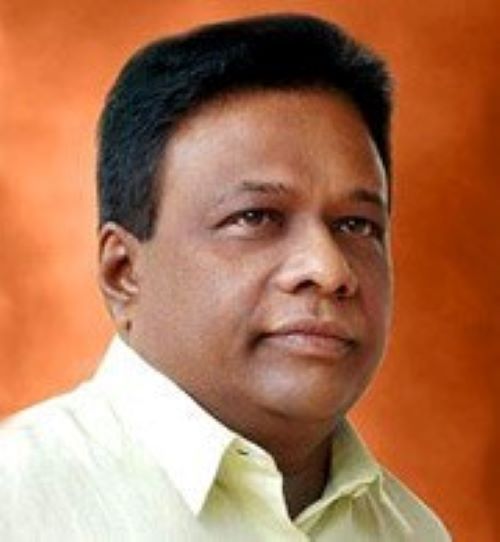Fact Check
To check this claim, FactCheck.lk consulted data from the Central Bank of Sri Lanka, the Department of Census and Statistics, and Sri Lanka Bureau of Foreign Employment and the World Bank.
The minister claims that (a) the USD 7 billion of foreign exchange remittance income is contributed by housemaids employed in the Middle East, (b) USD 5.6 billion in forex earnings is from the apparel sector and USD 2 billion is from the tea sector, (c) Both the apparel and tea sector are dominated by a female workforce.
On claim (a) the total remittances reported by the minister are correct, but the minister has over-attributed the remittance contribution from the Middle East, because ME accounted for only 3.7 billion of workers’ remittances (on average), not the total 7 billion. It is also notable that men outnumbered the recorded flow of women to the ME in the last five years.
On claim (b), net foreign exchange income, which is the relevant benefit to Sri Lanka from the apparel sector, was USD 2,431 million on average, due to the high import content in the exports, which creates an outflow of foreign exchange prior to the gross earnings of USD 5.6 billion. Income from tea exports is only about USD 1.4 billion, much less than the nearly USD 2 billion cited by the minister.
On claim (c), according to Annual Survey of Industries published by the Department of Census and Statistics, about 70% of the apparel sector work force consists of women. According to a sample survey conducted by the World Bank in 2012, the latest available data FactCheck.lk could find, about 53% of estate sector workers consist of women. Therefore, the minister is correct that the workforce of these sectors is dominated by women.
The minister is correct about women’s dominance in tea and apparel industries, but the numbers on foreign exchange benefit to Sri Lanka that are cited by him are wrong on all three counts as shown in Exhibit 1.
Therefore, we classify his statement as Partly True.
*FactCheck.lk‘s verdict is based on the most recent information that is publicly accessible. As with every fact check, if new information becomes available, FactCheck.lk will revisit the assessment.

Additional Note
Women being the dominant Sri Lankan migrant workforce in the ME is difficult to verify due to poor availability of data. (migration data in the last five years recorded more men going as workers to the Middle East).
Sources
Central Bank of Sri Lanka, External Sector Statistics, Exports, Imports and Trade, Exports – Annual (1990 to Latest) Table, available at: https://www.cbsl.gov.lk/en/statistics/statistical-tables/External-Sector [last accessed 5 April 2021]
Central Bank of Sri Lanka, External Sector Statistics, Earnings from Tourism and Workers’ Remittances, Workers Remittances (2009 January to Latest) Table, available at: https://www.cbsl.gov.lk/en/statistics/statistical-tables/External-Sector [last accessed 5 April 2021]
Central Bank of Sri Lanka, External Sector Statistics, Exports, Imports and Trade, Imports – Annual (1990 to Latest) Table, available at: https://www.cbsl.gov.lk/en/statistics/statistical-tables/External-Sector [last accessed 5 April 2021]
Central Bank of Sri Lanka, Economic and Financial Reports, Annual Report 2019, Statistical Appendix available at: https://www.cbsl.gov.lk/en/publications/other-publications/statistical-publications/economic-and-social-statistics-of-sri-lanka [last accessed 5 April 2021]
Central Bank of Sri Lanka, Publications, Other publications, Statistical publications, Economic & Social Statistics of Sri Lanka 2020 Report, available at: https://www.cbsl.gov.lk/en/publications/other-publications/statistical-publications/economic-and-social-statistics-of-sri-lanka [last accessed 11 April 2021]
Sri Lanka Bureau of Foreign Employment, Statistics, Annual Statistical Report of Foreign Employment – 2018, available at: Annual Statistical Report of Foreign Employment – 2018
Department of Census and Statistics, Industry, Annual Surveys, Annual Survey of Industries 2018, available at: http://www.statistics.gov.lk/Industry/StaticalInformation/AnnualSurveys/2018 [last accessed 5 April 2021]
Department of Census and Statistics, Labour Force, Annual Reports, Sri Lanka Labour Force Survey Annual Report 2018, available at: http://www.statistics.gov.lk/LabourForce/StaticalInformation/AnnualReports/2018 [last accessed 5 April 2021]
World Bank Group, Open Knowledge Repository, Getting to Work: Unlocking Women’s Potential in Sri Lanka’s Labor Force (2020) report, available at: https://openknowledge.worldbank.org [last accessed 27 April 2021]


